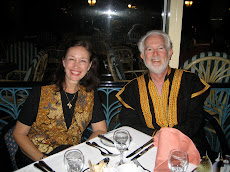Dalmatia was the birthplace of Diocletian when it was a Roman province. Though from humble origins he rose through the military ranks to ultimately become emperor of Rome. Born in the city of Solin, he returned to the city of Split to build his retirement palace, pictured below. The city of Split grew up over it and it was buried for centuries until excavated in more recent times. Our visit to Split took us to multiple levels in the city. 

 |
| Diocletian's Cellar |
 Diocletian's courtyard, complete with reenactors. The Romans had a "love affair" with all things Egyptian, importing the sphinxes here and sometimes building for themselves pyramids for tombs.
Diocletian's courtyard, complete with reenactors. The Romans had a "love affair" with all things Egyptian, importing the sphinxes here and sometimes building for themselves pyramids for tombs.A beautiful tradition of Croatia is the Klapa singing, a capella groups in each city that hold regular competitions. This group sings in the vestibule of the cathedral hourly. Their music is gorgeous! (jump forward to 1:28 mark to avoid all the introduction)
A link to a second group singing "Hallelujah."

The Cathedral of Saint Domnius, consecrated at the turn of the 7th century AD, is regarded as the oldest Catholic cathedral in the world that remains in use in its original structure, without near-complete renovation at a later date (though the bell tower dates from the 12th century). The structure itself, built in AD 305 as the Mausoleum of Diocletian, is the second oldest structure used by any Christian Cathedrall
The fun and irony of this is that, though Diocletian was the cause of the last, largest and bloodiest official persecution of the early Christians, they ultimately turned his mausoleum into a church!
 This boat on the side of the cathedral is an example of medieval Christian graffiti probably drawn by Christian Crusaders passing through on their way to the Holy Land.
This boat on the side of the cathedral is an example of medieval Christian graffiti probably drawn by Christian Crusaders passing through on their way to the Holy Land.  Following our visit to Split, our guide Haris took us to Trogir and Salona (once Solin and the birthplace of Diocletian.) Here is the remnant of the amphitheatre at Solin where Christians and gladiators fought.
Following our visit to Split, our guide Haris took us to Trogir and Salona (once Solin and the birthplace of Diocletian.) Here is the remnant of the amphitheatre at Solin where Christians and gladiators fought. |
| A Dalmatian house with a stone roof, typical of Dalmatia. |
Two tourists in Diocletian's courtyard













No comments:
Post a Comment